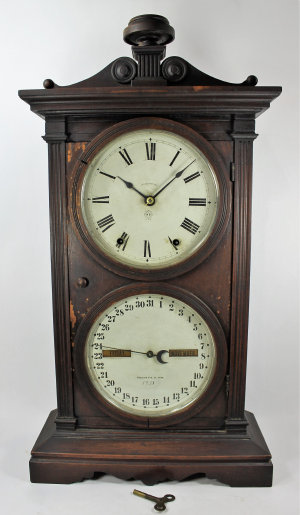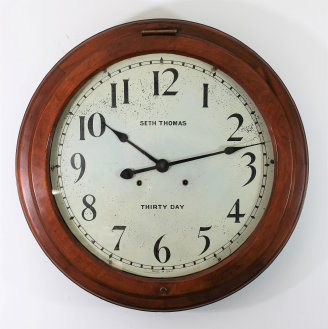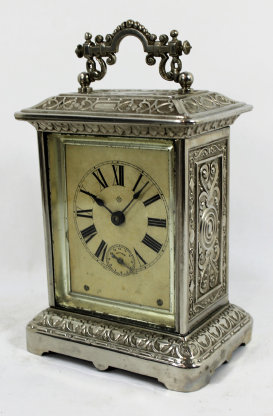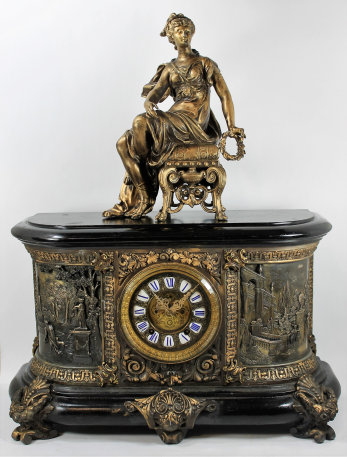


526. $125
Etalage Reclame Corp. “Prins”, ca. 1948. Leendert Prins patented the first “mystery clock” where the single glass dial rotates
with an attached hand assembly; this patent was later bought by Jefferson Electric Co. and led to the many “Golden” mystery clocks
you can now find on eBay and, occasionally, here. This was the first model. It appears they were all made at this
location in New York and marketed under various names by different companies. It stands on an oak base that houses the electric
motor made by Haydon Mfg. Co. which drives the glass dial through one full rotation every hour. There is a gear ring on the
glass hidden by the gold-plated bezel. The clock stands 10-inches tall and is a bit top-heavy; the bezel is also a bit loose
on its stand, but probably could be tightened up if you wish to remove the motor. The clock is running and keeping time, but
a bit noisy, and the glass is loose in the bezel. The power cord is original, as are all the parts. The gold-plated bezel
and hands show considerable wear, corrosion and oxidation, and some of the finish has been polished off. I have seen only two
of these clocks, they are not common. But this is the original “mystery clock”; one sold on eBay in March 2017 for $237. You can find out more about these clocks on Roger Russell’s website. $125-$250.
527. $350
Seth Thomas “Parlor Calendar No. 6”, 1896. A walnut case in its original finish I think, judging
by the decades of wax and grime on the surface. Some chipping to the veneer on the front door, most noticeable on the upper
left; the chips are very thin and could probably be covered quite adequately with a little carefully applied stain. There is
also a noticeable gap in the wood bezels where each circular piece is joined; they could be squeezed together if you wanted to make
the effort. The entire case needs a good degunking with Kotton Klenser (unless you like the aged look!). Both dials are
in their original paint, with no chipping and minimal soiling/wear. The dial glasses are also original; indeed, everything appears
original except the dial board, which may have been replaced. The signed movement, 8 days, time and strike, is running and striking
on cue; the calendar is advancing. The date is stamped on the backboard (May 1896) and there are labels inside in good shape. This clock came from a judge’s family in Floyd County Kentucky; the year 1931 is written in pencil on the calendar dial. There
is a business card inside from a long-gone jeweler in Lexington. It stands 27.25 inches tall. This model hasn’t come up
for sale on eBay or in our catalog in the last 5 years; Schmitt’s sold one with a replacement center finial for $600 in 2016 and for
$500 in 2015. $350-$500.


528. $400
Seth Thomas “Arcade No. 1”, ca. 1913. This gallery clock is 23 inches across with an 18-inch
dial; it is the smallest model Arcade. The case looks like cherry, but the book says it came in “mahogany finish and old oak”. The dial is clean with the original paint, but lots of fleck-sized losses. The hands are appropriate but not correct to this
model. The bezel opens from the top and holds a new glass. The 30-day signed double-spring movement has a Graham dead-beat
escapement and is running and keeping time, with a large, heavy nickel pendulum bob. I don’t see a label. Not so big as
to be overwhelming; this clock would fit nicely on a lot of walls. Prices are variable with this clock, starting at $400 at
Schmitt’s in 2015. $400-$750.
529. $400
Early weight-driven banjo. A 35-inch mahogany case with flame mahogany front boards. The throat board is split. There is no label or signature on the case, dial, or movement that we can find; the painted dial
is attached to the movement with four screws as a tall-case clock dial would be attached to a movement. There is a heavy thick
glass in the heavy brass bezel. The hands appear original. The weight-driven movement and pendulum are typical of banjos;
there are some oxidation spots on the bob. The weight is on a brass pulley behind a tin weight shield that seems to be original
(all the screw holes line up); for that matter, there are no additional dial holes or movement mounting holes. The 8-day time-piece
is running easily and keeping time. The wood finial on top may or may not be original, but it appears that there should also
be a finial on the unusual round bottom piece. All in all an atypical early banjo, but we are not banjo experts. The flame
mahogany case is nice for sure. $400-$1200.


530. $115
Ansonia “Carriage Extra” in nickel, ca. 1904. This is one of the larger carriage clocks, 6.5
inches high with the handle down. The dial is glossy paper, slightly yellowed, with an inset alarm dial. The hands are
correct. The nickel case is in nice shape, needing only a bit of polish; no nicks, dings, or dents that I see. The nickel
back door opens to a backwind time, alarm, and half-hour strike on a bell under the base. The strike is off by 15 minutes so
you will need to open the case and reposition the minute hand. The clock runs for a while and then stops. It’s only a
one-day clock anyway. These generally sell for around $150 on eBay when found in nickel. $125-$175.
531. $1250
Ansonia “Virginia” with top ornament, ca. 1904. This is one of those massive Ansonia
metal-case clocks, 20.5 inches across and 12 inches high (24 inches with statue), weighing over 40 lb with the statue on top. The statue here is No. 1022, “Opera” shown on page 655 of Ly’s book on Ansonia clocks. She is missing some of her accoutrements,
including a horn for her right hand and a side table or stand on her left. You would not know the side pieces are missing as
there is nothing broken off on the piece (note, however, that her left arm is split above the elbow). The metal case and the
statue have been lightly repainted, really sort of “brushed up” with gold paint over a brown base, at least on the statue it seems. For the most part it brightens the clock and statue and it is hard to tell how much has been done. The black gloss paint may
also have been touched up; there are the usual dull spots and such on the top. Note that the statue sits on top of the clock
and is not attached, there are no mounting holes, so the clock can be displayed with or without the statue. If you would like
the clock without the statue let us know on your bid sheet and we will give you a $50 discount. The cartouche dial sits behind
a thick beveled glass in the rococo sash; there is an open escapement in the center of the dial. All four feet and all attachments
are present and correct. The French-style movement is not running and it sounds like the time-side spring is either not attached
or broken. The only two recent sales of this clock were for $1610 and $1898, both in 2010 at R.O. Schmitt’s.
Left side Right side Movement Statue-left Statue-back Statue-right Without statue
